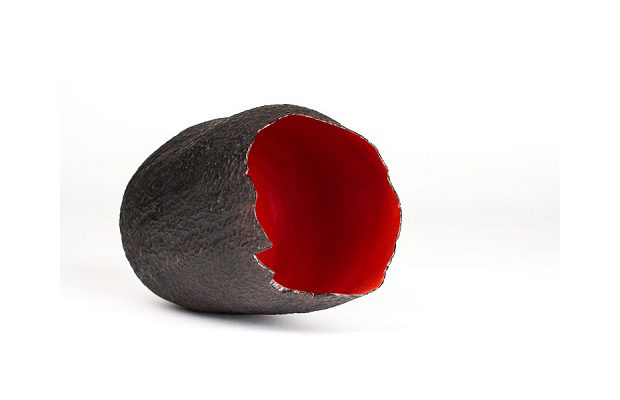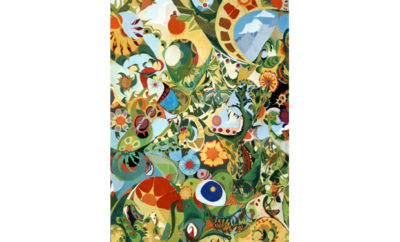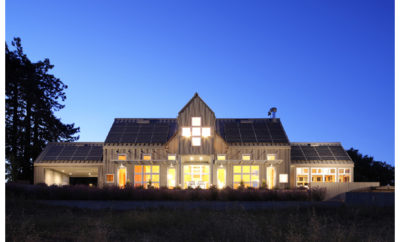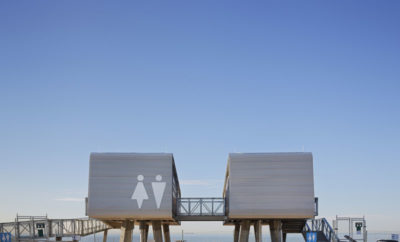
Feature
Gray Today
THE LEGACY OF EILEEN GRAY TAKES MANY FORMS IN THE WORK OF CONTEMPORARY IRISH DESIGNERS

The rough oak exterior of E.7. E.11 by Emmet Kane, 2015, contrasts sharply with the smooth, glistening surface of the lacquer interior.
EILEEN GRAY ONCE SAID, “SOMETIMES ALL THAT IS REQUIRED is the choice of a beautiful material worked with sincere simplicity.” One hundred years on, a new group of Irish designers has embraced Gray’s ethos, by applying it through a fusion of traditional ideas and modern materials and methods. A self-taught architect who helped change the face of the field in the 1920s, Gray was also a lacquer artist of formidable skill; a furniture designer who experimented with a variety of innovative materials such as celluloid, scorched wood, perforated metal, cork, and chrome; and a carpet designer whose work reflected the De Stijl, cubist, and Russian abstract art movements.
She was largely forgotten in her homeland until 1973, when an exhibition of her work was held in Dublin, a show that included a Transat chair, an S-bend chair, an Adjustable table, several carpets, and numerous images of her architectural projects. The National Museum of Ireland attempted to acquire a number of pieces from this exhibition, but it wasn’t until 2000 that it finally procured a collection and archive of her work, which went on permanent display in 2002. Since then Gray’s influence has become increasingly apparent in the new generation of Irish furniture designers, who have closely examined her work, her ideas, and her methods.

Eileen Gray’s Le Destin screen, 1913, inspired the Red writing desk designed by Neal and Annabel McCarthy’s firm, Nest, ninety years later.
Neil and Annabel McCarthy, who started their firm, Nest, in Cork in 2000 (in 2008 they relocated to the south of France), are among the designers who have been exploring Gray’s use of lacquer. Nest’s furniture is sleek, minimal, and functional, enhanced by innovative materials and an engaging use of color. The firm’s Red writing desk, 2003, celebrates Gray’s use of red lacquer in a number of her early pieces, most notably her four-panel screen Le Destin of 1913 and the Charioteer table of 1913–1915. In 2005 Nest won the prestigious Irish furniture “Oscar” for craftsmanship, presented by John Makepeace, with Black Monday, a walnut and maple sideboard finished in black lacquer. Nest continues to explore colorful lacquer in their work, such as the green Mantis table and the Phoenix writing desk completed in red, burnt orange, or bright yellow. “Taking Gray’s lead, we use lacquer to give emphasis to the form and lines of our work,” the McCarthys say.
Gray’s use of lacquer has also inspired Ireland’s woodturning community, as seen in a recent retrospective of work by Emmet Kane at the National Museum of Ireland (it’s due to travel to New York next year). Kane chose to use a contemporary resin lacquer instead of urushi, the Japanese lacquer that Gray preferred, as it is made of the resin from the highly toxic sap of the Rhus verniciflua tree. Nonetheless, he employs the same brushing techniques Gray used to build up the layers, creating a smooth, sumptuous surface that he juxtaposes with the rough texture of ebonized Irish burl oak in vessels such as E.7.E.11— its title itself an homage to Gray, who called the house she designed for herself and Jean Badovici in the south of France E.1027 (E for Eileen, 10 for the tenth letter of the alphabet, J[ean]; 2 for B[adovici]; and 7 for G[ray]). Using Gray’s numerical and alphabet system Kane’s E.7.E.11 can be decoded as E[ileen] 7 [Gray], E[mmet] 11 [Kane].

To achieve its texture, Gray scorched the wood for the pine top of this occasional table she made for her house Tempe à Pailla, 1938.
New York-born Susan Zelouf and Belfast’s Michael Bell, now working in County Laois, likewise combine indigenous woods, such as bog oak, with lacquer, and they often ri! on the Asian inspiration in Gray’s work. For instance, her Poissons carpet and a corresponding lacquer table with a design of koi fish (the table was illustrated in British Vogue in August 1917) inspired their Koi Noir table, executed in bog oak with a hand-rubbed lacquer surface inlaid with fish designs in black bolivar, ivory and gray ripple sycamore, and other woods. The table sparked a series of pieces with similar themes and palette, such as Koi Waterfall and Koi Shadows. For Koi Pond in the Snow, Zelouf and Bell created a wonderful outburst of color using stained woods overlaid with clear lacquer.

Koi Shadows low table by Zelouf and Bell, part of the Channel series, is made from fumed oak with gray sycamore, and marquetry in red birch, black bolivar, and ivory sycamore.
Zelouf and Bell are among a number of contemporary Irish designers who have reinterpreted the block screen Gray designed for the Monte Carlo room at the Fourteenth Salon des Artistes Décorateurs in 1923. They transmuted Gray’s idea of moveable geometric elements from the screen to their Briques sideboard, a low curved cabinet composed of rectangular sections of Macassar ebony and wenge finished in a high-gloss lacquer, and pinned with polished aluminum rods. But where the moveable element of Gray’s screen is straightforward, the sideboard is trickier: the doors open by touch—there are no handles—but touch one door and one beside it opens.

A nod to Gray’s iconic block screen, Zelouf and Bell’s Curved Briques sideboard, 2013, is composed of Macassar ebony “bricks” pinned with polished aluminum rods and finished with hand-rubbed gloss lacquer.
Intrigued by how Gray created textures and inspired by the natural beauty of Ireland’s landscape, John Lee in County Meath designed a series of pieces in oak, fumed oak, and wenge, beginning with the Carraig (meaning rock in Irish) chest of draw ers made in 2006. Gray played with different textures and materials in her furniture, for example scorching the wood and then sand ing it to create a rippled effect on a series of tables she made in the 1930s for her second home, Tempe à Pailla, near Menton in the south of France. Lee hand-shapes and carves his pieces, then finishes them by grit blasting the surface with copper slag to achieve an intricate, rippled texture. Other examples include the Farraige (wave) chest of drawers (2008) and the tall chests Carrigeen (small rocks, 2009) and Iasc (fish, 2010). Lee, like Gray, is also interested in a humanist approach to furniture, tailoring each piece to the user in the way he adapts drawers to slide open with just the touch of the fingers or the way he lines his drawers with soft leather. Of Gray’s influence, he says, “it’s her design ethos, pursuit of perfection and fluid use of materials that particularly influence my work. I find it inspirational to see her fear less experimentation with various mediums and techniques.”

Iasc tall chest by Lee in fumed oak with contrasting textured surfaces, 2010.

Carraig chest of drawers by John Lee, 2006.
Ireland’s natural beauty also comes into play in the work of Sasha Sykes, a designer of functional art, furniture, and lighting who draws inspiration from the rural and agricultural heritage of her native County Carlow. Using materials and processes she spent the last decade developing, Sykes embeds organic materials in resins and acrylics whose lucidity and transparency permit her to preserve the color and fragility of flora and fauna in various stages of the life cycle. The screen shown here was made on commission from the National Museum of Ireland as a play on Gray’s block screens.
Drawing on art, philosophy, travel, and daily life in Carlow, Sykes also brings her fascination with walls to bear in the screen, especially after a trip to Berlin in 2008, where she was drawn particularly to the theme of torn-down walls. Though the screen is a type of wall, in its transparency Sykes has challenged the notion of privacy that a wall suggests.

Gray’s white block screen for the Monte Carlo room at the Fourteenth Salon des Artistes Décorateurs in 1923.
Sourcing her organic material from the area around her farm in Rathvilly, Sykes placed woodland debris at the base. Then grasses, mosses, brambles, mushrooms, cones, leaves, ferns, and lichens appear. Leaves and ivy hang down over the top. Hints of animal life appear throughout in the form of eggshells, feathers, beetles, and butterflies. Encapsulated in one block is a circle of hydrangeas. A UV barrier in the resin protects the colors of the delicate and transient organic materials, which are frozen between life and decay.
The process of embedding the organic material in the resin took nearly a year. Sykes says that she has “a fascination with materials and their potential to re-present an object and to awaken a forgotten idea in the minds of users.” This may be Sykes’s interpretation of Eileen Gray’s block screen, but the method, the medium, and the philosophy are Sykes’s own.












